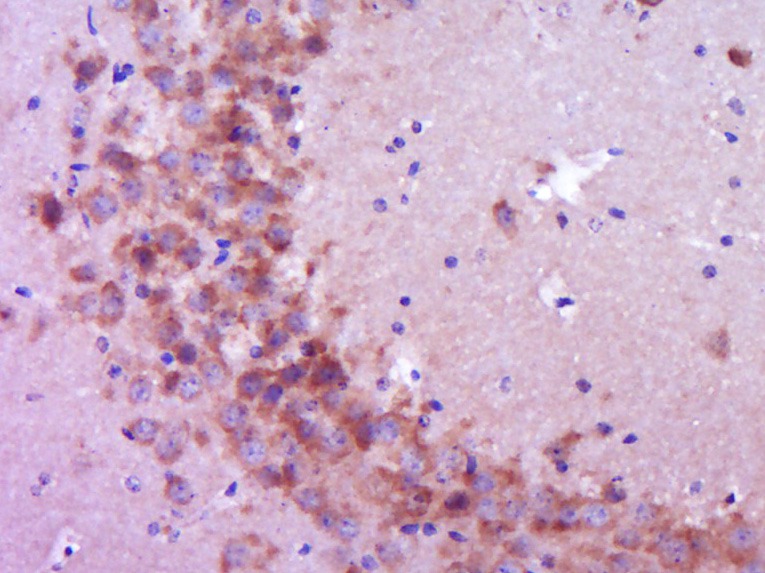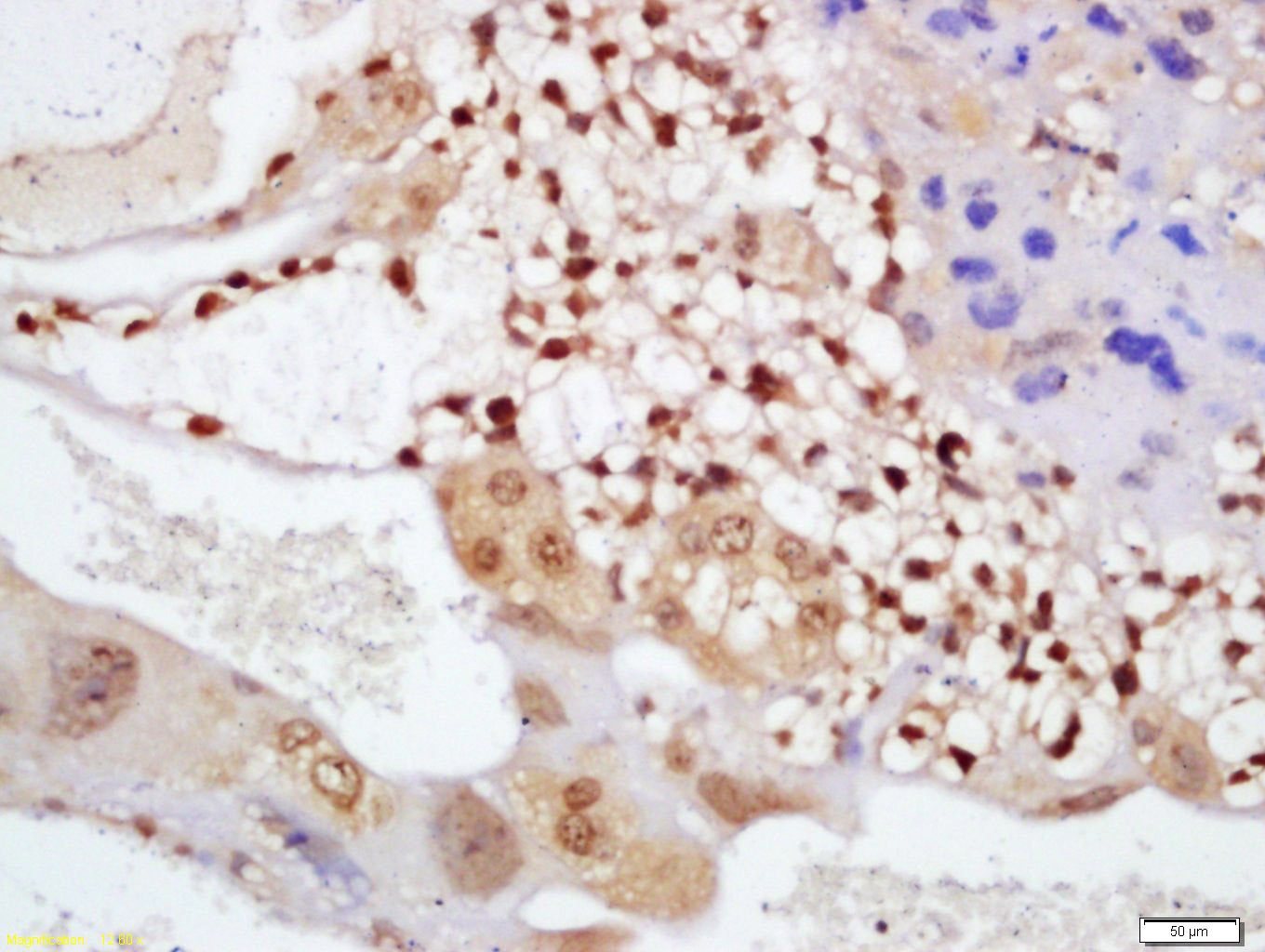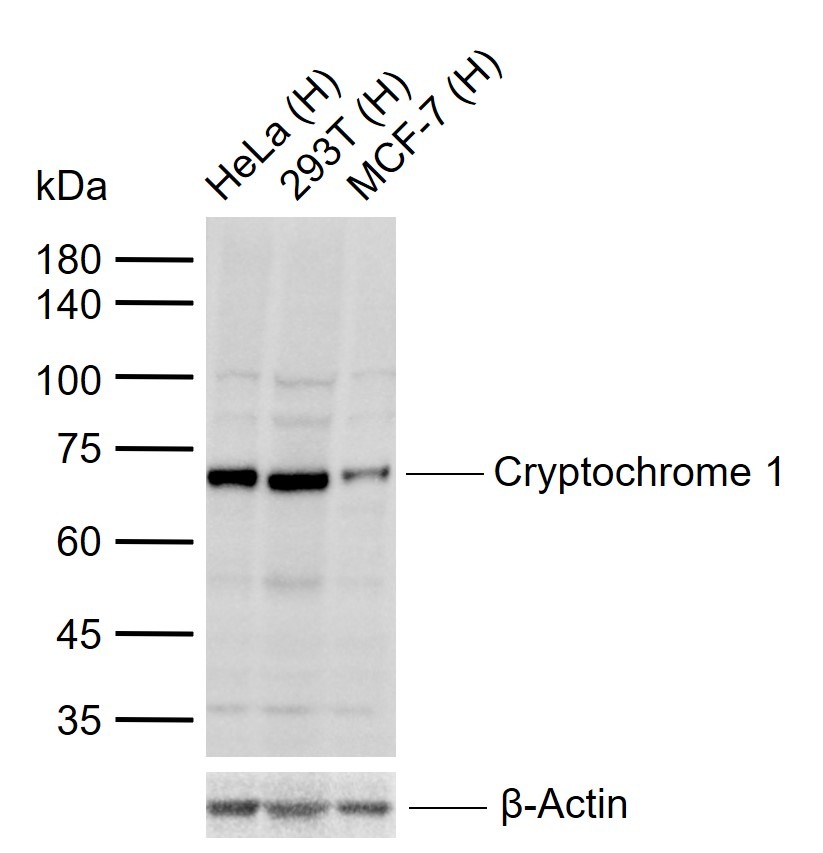Shopping Cart
Remove All Your shopping cart is currently empty
Your shopping cart is currently empty
Anti-CRY1 Polyclonal Antibody is a Rabbit antibody targeting CRY1. Anti-CRY1 Polyclonal Antibody can be used in IF,IHC-Fr,IHC-P,WB.
| Pack Size | Price | USA Warehouse | Global Warehouse | Quantity |
|---|---|---|---|---|
| 50 μL | $221 | 7-10 days | 7-10 days | |
| 100 μL | $372 | 7-10 days | 7-10 days | |
| 200 μL | $529 | 7-10 days | 7-10 days |
| Description | Anti-CRY1 Polyclonal Antibody is a Rabbit antibody targeting CRY1. Anti-CRY1 Polyclonal Antibody can be used in IF,IHC-Fr,IHC-P,WB. |
| Synonyms | PHLL1, Cryptochrome-1, CRY1 |
| Ig Type | IgG |
| Reactivity | Human,Mouse (predicted:Rat,Chicken,Dog,Pig,Cow,Rabbit,Sheep) |
| Verified Activity | 1. Paraformaldehyde-fixed, paraffin embedded (Mouse brain); Antigen retrieval by boiling in sodium citrate buffer (pH6.0) for 15 min; Block endogenous peroxidase by 3% hydrogen peroxide for 20 min; Blocking buffer (normal goat serum) at 37°C for 30 min; Antibody incubation with (Cryptochrome 1) Polyclonal Antibody, Unconjugated (TMAB-00484) at 1:400 overnight at 4°C, followed by operating according to SP Kit (Rabbit) instructionsand DAB staining. 2. Tissue/cell: mouse placenta tissue; 4% Paraformaldehyde-fixed and paraffin-embedded; Antigen retrieval: citrate buffer (0.01M, pH6.0), Boiling bathing for 15 min; Block endogenous peroxidase by 3% Hydrogen peroxide for 30 min; Blocking buffer (normal goat serum) at 37°C for 20 min; Incubation: Anti-Cryptochrome-1 Polyclonal Antibody, Unconjugated (TMAB-00484) 1:200, overnight at 4°C, followed by conjugation to the secondary antibody and DAb staining. 3. Sample: Lane 1: Human HeLa cell lysates Lane 2: Human 293T cell lysates Lane 3: Human MCF-7 cell lysates Primary: Anti-Cryptochrome 1 (TMAB-00484) at 1/1000 dilution Secondary: IRDye800CW Goat Anti-Rabbit IgG at 1/20000 dilution Predicted band size: 64 kDa Observed band size: 70 kDa    |
| Application | |
| Recommended Dose | WB: 1:500-2000; IHC-P: 1:100-500; IHC-Fr: 1:100-500; IF: 1:100-500 |
| Antibody Type | Polyclonal |
| Host Species | Rabbit |
| Subcellular Localization | Cytoplasm. Nucleus. Translocated to the nucleus through interaction with other Clock proteins such as PER2 or ARNTL. |
| Construction | Polyclonal Antibody |
| Purification | Protein A purified |
| Appearance | Liquid |
| Formulation | 0.01M TBS (pH7.4) with 1% BSA, 0.02% Proclin300 and 50% Glycerol. |
| Concentration | 1 mg/mL |
| Research Background | Circadian clocks are biological timepieces that regulate hormonal rhythms, sleep cycles and feeding behaviors. These rhythms are generated in the superchiasmatic nucleus (SCN), a cell-autonomous circadian oscillator located within the brain that is synchronized with the environment by light. A number of transcription factors, including Clock and BMAL1, are molecular components of the SCN that induce the expression of proteins involved in light/dark cycle entrainment, which include Per1 and Per2. Tim, for timeless, generates a negative feedback loop that regulates the activity of Clock by suppressing the expression of Clock target genes. Tim forms heterodimers with Per1 and Per2 that bind Clock and block the activation of Clock-BMAL1 dimers to repress Per gene expression. Additionally, the CRY proteins, which are cryptochrome photoreceptors for the circadian clock, function as light-independent inhibitors of the circadian clock. CRY1 and CRY2 negatively regulate SCN components by associating with the activators Clock-BMAL1, and also with the various feedback inhibitors Per1, Per2 and Tim. |
| Immunogen | KLH conjugated synthetic peptide: human Cryptochrome 1 |
| Antigen Species | Human |
| Gene Name | CRY1 |
| Gene ID | |
| Protein Name | Cryptochrome-1 |
| Uniprot ID | |
| Biology Area | Blood Pressure regulation,Catecholamines,Circadian Rhythm,Receptors,More GPCR,Visual system |
| Function | Blue light-dependent regulator of the circadian feedback loop. Inhibits CLOCK NPAS2-ARNTL E box-mediated transcription. Acts, in conjunction with CRY2, in maintaining period length and circadian rhythmicity. Has no photolyase activity. Capable of translocating circadian clock core proteins such as PER proteins to the nucleus. May inhibit CLOCK. |
| Molecular Weight | Theoretical: 64 kDa. |
| Stability & Storage | Store at -20°C or -80°C for 12 months. Avoid repeated freeze-thaw cycles. |
| Transport | Shipping with blue ice. |
| Size | Quantity | Unit Price | Amount | Operation |
|---|

Copyright © 2015-2026 TargetMol Chemicals Inc. All Rights Reserved.